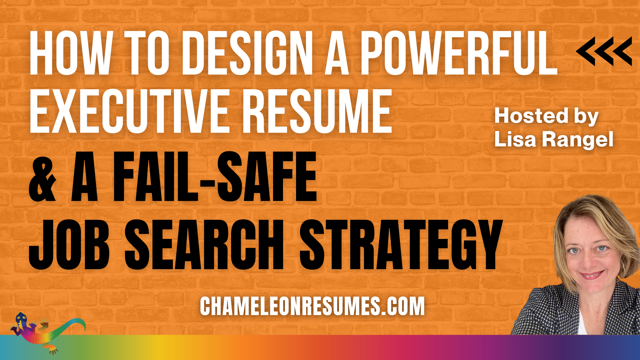6 Iron-Clad Ways To Find Keywords To Optimize Your Executive Resume

 Optimizing your executive resume means your executive resume must be “SEO friendly” to be found by recruiters looking for candidates like you. More specifically, this means that it has to be rich in keywords that are relevant to the position you are applying to, in order to get past the online screening process and the human being reading/scanning your resume. There is a very fine line, however, between having the right number of keywords to get you through to the next level, and matching the job description so closely that the system will think you are a spammer.
Optimizing your executive resume means your executive resume must be “SEO friendly” to be found by recruiters looking for candidates like you. More specifically, this means that it has to be rich in keywords that are relevant to the position you are applying to, in order to get past the online screening process and the human being reading/scanning your resume. There is a very fine line, however, between having the right number of keywords to get you through to the next level, and matching the job description so closely that the system will think you are a spammer.
Here are six ways to find keywords to optimize your executive resume, and how to ensure your resume gets passed on to recruiters.
1. Use the Occupational Outlook Handbook (Bureau of Labor Statistics)
The Occupational Outlook Handbook found on the Bureau and Labor Statistics website, can be a wealth of information for executive career advancers and career changers. Choose your target occupation and you will find relevant keyword clues on the What They Do, Work Environment and How to Become One pages. These profiles tend to be more specific for scientific, engineering, healthcare and technology positions. Yet chief executives, sales professionals and creative positions are well represented with data, as well.
2. Learn how to use AutoCoder
AutoCoder is an effective tool, from O*Net OnLine, for recruiters and job hunters that most have worked with before. Here is where you can get your edge. Essentially, you input the job title and job description for any position, and it will output a standard set of position matches and keywords for that role. This information will help you identify the critical keywords for that position; the same keywords that the online application system will be searching for.
For example, if you were interested in landing a Director of Business Development position, you would run a specific job posting through the system with the title, and end up with a list of keywords including Sales Director and Director of Marketing as potential job titles along with how often certain words come up in the job description.
The frequency and score of certain phrases indicates what needs to be contained within your executive resume. In the example above, you should include “sales manager,” “manager,” “development manager,” and “business development” on your resume, weighted in value.
3. Target keywords through visuals
When you have a job description, you have the necessary information to understand what is important to the hiring manager. Unfortunately, in text versions, it’s very difficult to figure out the priority of different values or emphasis on various actions.
That’s where online word cloud tools come into play. Sites like TagCrowd allow you to enter the text of the job description, and then you get a visual emphasis on the critical components. Using the same job description used above, here is the TagCrowd graphic with a strong emphasis on engineering, client, military and development – different words than position-specific keywords from AutoCoder.
In addition to visualizing the job description, you should also get a visual for your current resume, cover letter, and any other job search materials to cross-reference keyword needs. Once you’re in the interview phase or ready to target a specific company, you can also enter the company mission statement or “about” information to get a better understanding of what they value, company-wide.
4. Meet the company’s keywords halfway
Your resume’s keywords should not only match the required necessary skills, but the company’s overall culture and environment should be represented as well. Companies are looking for employees that “complete them,” just like that famous Jerry Maguire line.
Your resume should contain culture-specific references, ideals and values that are important to company culture. If you are seeking an innovative culture, then your resume should include examples of innovation and that word should be present. If you want to work at a Fortune 500 company, then your resume should have that phrase in it, and so on.
Show the target companies that you possess the softer-skills they are seeking, not only the tactical delivery of the position. Using keywords is an easy way to reinforce your overall culture fit.
5. Using the right language and different versions of expression
There are few things that will confuse an online application more quickly than using the wrong “language.” Many resumes do not make it through the initial screen because they only contain various acronyms or use titles that are not widely accepted/known. Use both the proper name, the universal term and the acronym so all of your audiences will be familiar with your expertise and your resume will have multiple chances to make it through the ATS system.
People outside of your current organization do not understand the acronyms you use, so spell each of them out unless it is a widely accepted industry standard. An example of an accepted acronym: GAAP for accounting and finance positions. All other acronyms that do not meet this recognized standard, will serve you better by having the relevant words spelled out in your resume.
Titles are not standardized across industry or company, so it is critical that you include the right descriptive information when referring to current/previous titles. When you default to using your company-specific titles only, you may end up with something like this: Manager.
For a recruiter or the online system, it is very unclear what your actual duties were as a “Vice President.” You are missing a functional or departmental descriptor, something like: Vice President, Internet Marketing. Be sure to include these details in your executive resume.
6. Employ SEO (Search Engine Optimization) Techniques to Optimize Your Resume
Include an SEO approach to enhance your resume with keywords to increase your odds of getting through the initial “robot” review of your resume and get your resume in the hands of the hiring manager. Not only will it help your resume be seen, but it will also increase your subject matter credibility, instantly. Learn optimization techniques from websites such as www.SearchEngineJournal.com, www.SocialMediaExaminer.com, and www.SearchEngineLand.com to learn how keyword phrases are discovered to use the best processes and tactics to employ to construct your resume. Once you learn these techniques, hop over to Google AdWords Key Word Planner, open a free account, and start to hone in on the right keywords for your target position, based on the information discovered from the first five tactics.
Using these tools to identify the right keywords and use them most effectively in the content of your resume will optimize your resume in an expert manner. While nothing is a replacement for sending your resume to a human, you need to make sure that your resume can beat the technology systems where your resume may be housed until the right match comes along. The overall goal is for your resume to quickly be found in a technical search.
If you want to learn other strategies for creating an effective resume attend my resume writing masterclass. Register below:
- How to brand yourself on your resume so hiring managers and recruiters can instantly establish your value
- Why the resume is only worth 25% of your job search efforts and where else you should put your focus
- What the *actual* goal of a resume is (it’s not what you think it is)
- How to handle ageism when you’ve been in the game 25 plus years
- Why the ATS could be the downfall of your job search
- And so much more solid and proven executive-level job search advice
Join the tens of thousands of attendees worldwide who have found amazing value in this no-cost-to-you training.


 (917) 447-1815
(917) 447-1815